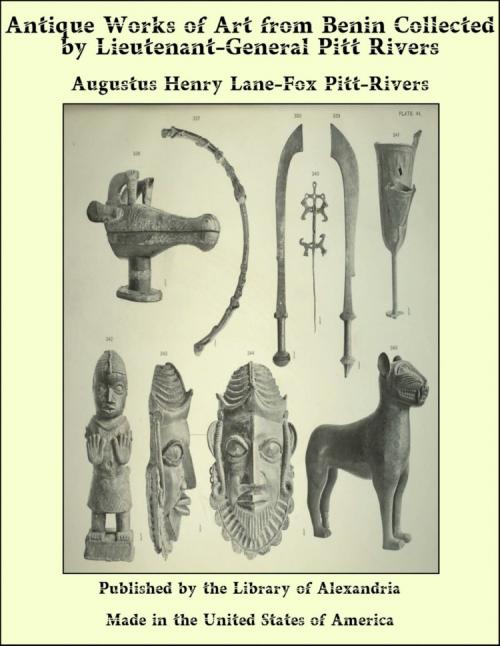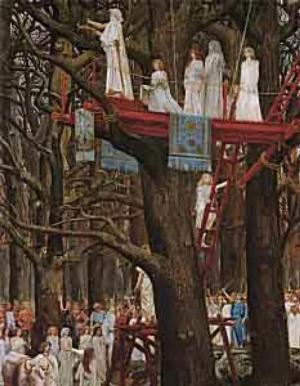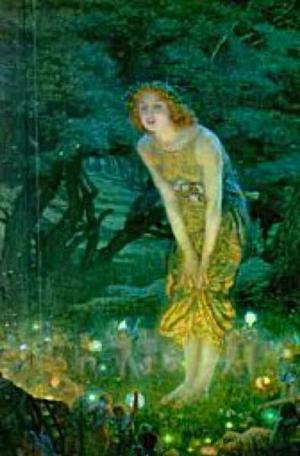Antique Works of Art from Benin Collected by Lieutenant-General Pitt Rivers
Nonfiction, Religion & Spirituality, New Age, History, Fiction & Literature| Author: | Augustus Henry Lane-Fox Pitt-Rivers | ISBN: | 9781465588937 |
| Publisher: | Library of Alexandria | Publication: | March 8, 2015 |
| Imprint: | Language: | English |
| Author: | Augustus Henry Lane-Fox Pitt-Rivers |
| ISBN: | 9781465588937 |
| Publisher: | Library of Alexandria |
| Publication: | March 8, 2015 |
| Imprint: | |
| Language: | English |
Benin is situated on the Guinea Coast, near the mouth of the Niger, in latitude 6·12 north, and longitude 5 to 6 east. It was discovered by the Portuguese at the end of the fourteenth or commencement of the fifteenth centuries. The Portuguese were followed by the Dutch and Swedes, and in 1553 the first English expedition arrived on the coast, and established a trade with the king, who received them willingly. Benin at that time appears by a Dutch narrative to have been quite a large city, surrounded by a high wall, and having a broad street through the centre. The people were comparatively civilized. The king possessed a number of horses which have long since disappeared and become unknown. Faulkner, in 1825, saw three solitary horses belonging to the king, which he says no one was bold enough to ride. In 1702 a Dutchman, named Nyendaeel, describes the city, and speaks of the human sacrifices there. He says that the people were great makers of ornamental brass work in his day, which they seem to have learnt from the Portuguese. It was visited by Sir Richard Burton, who went there to try to put a stop to human sacrifices, at the time he was consul at Fernando Po. In 1892 it was visited by Captain H. L. Galloway, who speaks of the city as possessing only the ruins of its former greatness; the abolition of the slave trade had put a stop to the prosperity of the place, and the king had prohibited any intercourse with Europeans. The town had been reduced to a collection of huts, and its trade had dwindled down to almost nil. The houses have a sort of impluvium in the centre of the rooms, which has led some to suppose that their style of architecture may have been derived from the Roman colonies of North Africa. In 1896 an expedition, consisting of some 250 men, with presents and merchandise, left the British settlements on the coast, and endeavoured to advance towards Benin city. The expedition was conducted with courage and perseverance, but with the utmost rashness. Almost unarmed, neglecting all ordinary precautions, contrary to the advice of the neighbouring chiefs, and with the express prohibition of the King of Benin to advance, they marched straight into an ambuscade which had been prepared for them in the forest on each side of the road, and as their revolvers were locked up in their boxes at the time, they were massacred to a man with the exception of two, Captain Boisragon and Mr. Locke, who, after suffering the utmost hardships, escaped to the British settlements on the coast to tell the tale.
Benin is situated on the Guinea Coast, near the mouth of the Niger, in latitude 6·12 north, and longitude 5 to 6 east. It was discovered by the Portuguese at the end of the fourteenth or commencement of the fifteenth centuries. The Portuguese were followed by the Dutch and Swedes, and in 1553 the first English expedition arrived on the coast, and established a trade with the king, who received them willingly. Benin at that time appears by a Dutch narrative to have been quite a large city, surrounded by a high wall, and having a broad street through the centre. The people were comparatively civilized. The king possessed a number of horses which have long since disappeared and become unknown. Faulkner, in 1825, saw three solitary horses belonging to the king, which he says no one was bold enough to ride. In 1702 a Dutchman, named Nyendaeel, describes the city, and speaks of the human sacrifices there. He says that the people were great makers of ornamental brass work in his day, which they seem to have learnt from the Portuguese. It was visited by Sir Richard Burton, who went there to try to put a stop to human sacrifices, at the time he was consul at Fernando Po. In 1892 it was visited by Captain H. L. Galloway, who speaks of the city as possessing only the ruins of its former greatness; the abolition of the slave trade had put a stop to the prosperity of the place, and the king had prohibited any intercourse with Europeans. The town had been reduced to a collection of huts, and its trade had dwindled down to almost nil. The houses have a sort of impluvium in the centre of the rooms, which has led some to suppose that their style of architecture may have been derived from the Roman colonies of North Africa. In 1896 an expedition, consisting of some 250 men, with presents and merchandise, left the British settlements on the coast, and endeavoured to advance towards Benin city. The expedition was conducted with courage and perseverance, but with the utmost rashness. Almost unarmed, neglecting all ordinary precautions, contrary to the advice of the neighbouring chiefs, and with the express prohibition of the King of Benin to advance, they marched straight into an ambuscade which had been prepared for them in the forest on each side of the road, and as their revolvers were locked up in their boxes at the time, they were massacred to a man with the exception of two, Captain Boisragon and Mr. Locke, who, after suffering the utmost hardships, escaped to the British settlements on the coast to tell the tale.















